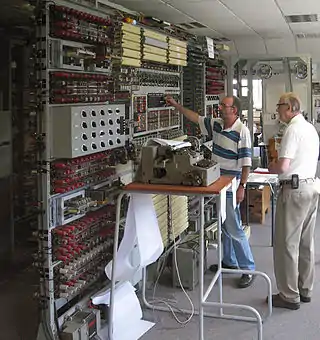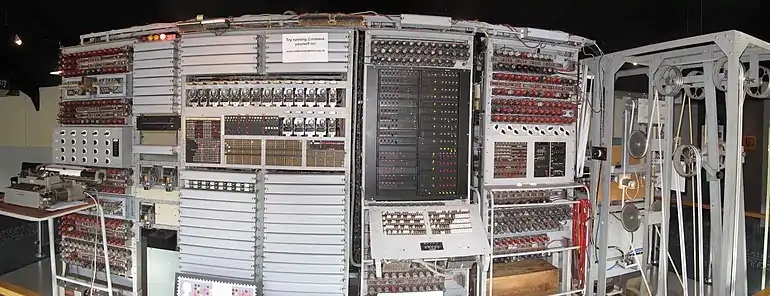Tony Sale
Anthony Edgar "Tony" Sale, FBCS (30 January 1931 – 28 August 2011) was a British electronic engineer, computer programmer, computer hardware engineer, and historian of computing. He led the construction of a fully functional Mark 2 Colossus computer between 1993 and 2008.[1][2] The rebuild is exhibited at The National Museum of Computing at Bletchley Park in England.[3]


Life
He was educated at Dulwich College in south London,[4] During his adolescence he built George the robot out of Meccano, and continued working on it until it reached a fourth version in 1949, when it was given much media coverage.[5][6] Sale joined the Royal Air Force in 1949, serving until 1952. During his three years in the RAF, Sale gained a commission and reached the rank of Flying Officer. He was an instructor at RAF Officers Radar School at RAF Debden.[6] Sale worked as an engineer for MI5 under Peter Wright in the 1950s.[4]
Between 1992 and 2007, Sale and volunteers rebuilt a functioning model of the Colossus (computer) Mark II which is on display at The National Museum of Computing at Bletchley Park.[7][8]
Sale lived beside his wife, Margaret, three children and seven grandchildren.
Work
Sale worked with Marconi Research Laboratories, was Technical Director of the British Computer Society and managed the Computer Restoration Project at the Science Museum.[9]
After becoming interested in computers, he joined the British Computer Society (BCS) in 1965 as Associate Member, being elected to Member in 1967, Fellow in 1988 and Honorary Fellow in 1996. He was elected to the Council of the BCS for the period 1967–70. In 1965, was a founder member of the Bedfordshire branch of the BCS and was named Chairman in 1979.[9]
In 1989, Sale was appointed a senior curator at the Science Museum in London and worked with Doron Swade to restore some of the museum's computer holdings.[4] He was part of the group that started the Computer Conservation Society in 1989 and was associated with the Bletchley Park Trust from 1992 onwards.[10] In 1991, he joined the campaign to save Bletchley Park from housing development.
In 1992, he was Secretary to the newly formed Bletchley Park Trust, later unpaid Museums Director in 1994.[9] In 1993 he started the Colossus Rebuild Project, inaugurated in 1994,[11] to rebuild the Colossus computer developed and built by Tommy Flowers at the Post Office Research Station at Dollis Hill in 1943.
Sale lectured on wartime code breaking in the UK, Europe and the US. He was technical adviser for the 2001 film Enigma.[12]
Sale's web site, Codes and Ciphers in the Second World War is a source of information on aspects of World War II code breaking. His booklet Colossus 1943–1996[13] outlines the breaking of the German Lorenz cipher and his remarkable rebuilding of the Colossus computer.

Honours
As a result of his Colossus rebuild work,[7] Sale was awarded the Comdex IT Personality of the Year for 1997.[16] He also received the 2000 Royal Scottish Society of Arts Silver Medal.[17]
After his death, the British Computer Conservation Society established in 2012 the Tony Sale Award for Computer Conservation and Restoration. It comprises a trophy and a travel bursary.[18]
In September 2019, Sale was posthumously awarded an Honorary Fellowship of the National Museum of Computing.[19]
References
- Sale, Tony. "Video of Tony Sale talking about rebuilt Colossus 2008-6-19". Retrieved 13 May 2017.
- "Tony Sale obituary". The Guardian. 31 August 2011.
- Colossus – The Rebuild Story, The National Museum of Computing, retrieved 13 May 2017
- Campbell-Kelly, Martin (31 August 2011), "Tony Sale obituary", The Guardian, retrieved 31 August 2011
- "Robot George: early humanoid revived after 45 years". The Daily Telegraph. 22 November 2010. Archived from the original on 24 November 2010. Retrieved 26 November 2010.
- "A walk of fame for George the robot". BBC News. BBC. 17 November 2010. Retrieved 30 August 2011.
- "Computer conservationist Sale dies". BBC News.
- The Colossus Gallery, The National Museum of Computing, retrieved 13 May 2017
- Tony Sale. "Tony Sale CV". codesandciphers.org.uk. Retrieved 31 August 2011.
- "Tony Sale on the regeneration of Bletchley Park". Open University. Retrieved 23 November 2010.
- p. 150, Colossus: the secrets of Bletchley Park's code-breaking computers, B. Jack Copeland, Oxford University Press, 2006, ISBN 0-19-284055-X Google Books
- Jagger's at breaking point over code, Henry Fitzherbert, Daily Express, 26 August 2001
- Sale, Tony (2004) [1998], The Colossus Computer 1943–1996 and how it helped to break the German Lorenz cipher in WWII, Cleobury Mortimer: M & M Baldwin, ISBN 0-947712-36-4 – A slender (20-page) booklet
- Sale, Tony, The Colossus its purpose and operation
- "coltalk_2". codesandciphers.org.uk.
- Nicolle, Lindsay, Whizkids no match for wartime wizards, The Times, 7 May 1997.
- Minutes, Opening Meeting of the 180th Session (2000-2001), RSSA official site
- "Welcome to the Tony Sale award web site". Computer Conservation Society. Retrieved 12 October 2012.
- "TNMOC Press Release". The National Museum Of Computing. Retrieved 17 September 2023.